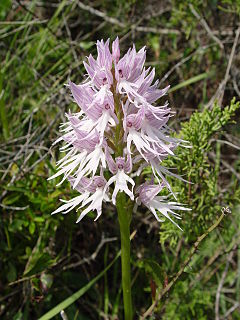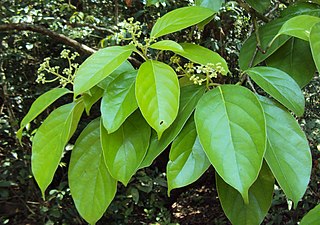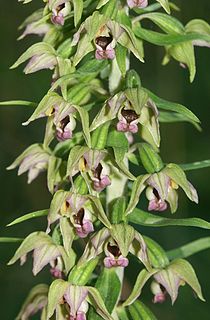
Anacamptis is a genus of flowering plants in the orchid family (Orchidaceae); it is often abbreviated as Ant in horticulture. This genus was established by Louis Claude Richard in 1817; the type species is the pyramidal orchid and it nowadays contains about one-third of the species placed in the "wastebin genus" Orchis before this was split up at the end of the 20th century, among them many that are of hybrid origin. The genus' scientific name is derived from the Greek word anakamptein, meaning "to bend backwards".

Freesia is a genus of herbaceous perennial flowering plants in the family Iridaceae, first described as a genus in 1866 by Christian Friedrich Ecklon (1886) and named after the German botanist and medical practitioner, Friedrich Freese (1795-1876). It is native to the eastern side of southern Africa, from Kenya south to South Africa, most species being found in Cape Provinces. Species of the former genus Anomatheca are now included in Freesia. The plants commonly known as "freesias", with fragrant funnel-shaped flowers, are cultivated hybrids of a number of Freesia species. Some other species are also grown as ornamental plants.

Crotalaria is a genus of flowering plants in the legume family Fabaceae commonly known as rattlepods. The genus includes about 500 species of herbaceous plants and shrubs. Africa is the continent with the majority of Crotalaria species, which are mainly found in damp grassland, especially in floodplains, depressions and along edges of swamps and rivers, but also in deciduous bush land, roadsides and fields. Some species of Crotalaria are grown as ornamentals. The common name rattlepod or rattlebox is derived from the fact that the seeds become loose in the pod as they mature, and rattle when the pod is shaken. The name derives from the Ancient Greek κρόταλον, meaning "castanet", and is the same root as the name for the rattlesnakes (Crotalus).

Cynodon is a genus of plants in the grass family. It is native to warm temperate to tropical regions of the Old World, as well as being cultivated and naturalized in the New World and on many oceanic islands.

Brassica juncea, commonly brown mustard, Chinese mustard, Indian mustard, leaf mustard, Oriental mustard and vegetable mustard, is a species of mustard plant.

Orchis is a genus in the orchid family (Orchidaceae), occurring mainly in Europe and Northwest Africa, and ranging as far as Tibet, Mongolia, and Xinjiang. The name is from the Ancient Greek ὄρχις orchis, meaning "testicle", from the appearance of the paired subterranean tuberoids.

Orchis mascula, the early-purple orchid, early spring orchis, is a species of flowering plant in the orchid family, Orchidaceae.

Mastixia is a genus of about 19 species of resinous evergreen trees, usually placed in the family Cornaceae. Its range extends from India through Southeast Asia and New Guinea to the Solomon Islands. Mastixia species have alternate or opposite simple broad leaves, many-flowered inflorescences, and blue to purple drupaceous fruits.

Dactylorhiza traunsteineri, the narrow-leaved marsh orchid or Traunsteiner's dactylorhiza, is a terrestrial species of orchid native to the cooler parts of the Eastern Hemisphere. It is native to Scandinavia, the Alps, and a region extending from Germany to Western Siberia. Although said by some sources to occur in Britain and Ireland, others say that plants identified as this species are actually Dactylorhiza majalis subsp. traunsteinerioides, a view supported by genetic data.

Epipactis helleborine, the broad-leaved helleborine, is a terrestrial species of orchid with a broad distribution. It is a long lived herb which varies morphologically with ability to self-pollinate.

Himantoglossum is a genus of orchids native to the Canary Islands, Europe, southwest Asia and northern Africa. Its members generally have a labellum which is divided into three parts, of which the middle part is the longest.

Tillandsia utriculata, commonly known as the spreading airplant or the giant airplant, is a species of bromeliad that is native to Florida and Georgia in the United States, the Caribbean, southern and eastern Mexico, Central America, and Venezuela.
Froelichia juncea is a plant species native to the Galápagos Islands of Ecuador. There are two subspecies of F. juncea: F. juncea subsp. juncea and F. juncea subsp. alata. F. juncea subsp. alata was first described by Thomas J. Howell.

Tulipa sylvestris, the wild tulip or woodland tulip, is a Eurasian and North African species of wild tulip, a plant in the lily family. Its native range extends from Portugal and Morocco to western China, covering most of the Mediterranean and Black Sea Basins, and Central Asia. The species is also cultivated as an ornamental and naturalized in central and northern Europe as well as a few scattered locations in North America. It is a bulb-forming perennial, usually with yellow flowers, sometimes tinged red on the outside.

Conophytum bilobum is a plant in the family Aizoaceae, native to southern South Africa. It blooms in autumn. It is scentless and grows to a height of 7 cm (2.8 in). The specific epithet bilobum comes from the two-lobed bodies these plants possess.

Justicia petiolaris is a plant species in the family Acanthaceae. It is native to Swaziland and eastern and southern South Africa.
Artocarpus rigidus is a tree species in the Moraceae that was described by Blume. A. rigidus is a wild species of the breadfruit/jackfruit genus (Artocarpus) and may be referred to as the 'monkey jack(fruit)'; its Vietnamese name is mít nài.
The anthophytes are a grouping of plant taxa bearing flower-like reproductive structures. They were formerly thought to be a clade comprising plants bearing flower-like structures. The group contained the angiosperms - the extant flowering plants, such as roses and grasses - as well as the Gnetales and the extinct Bennettitales.















